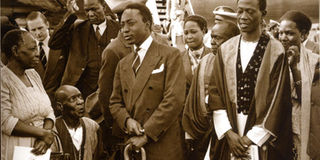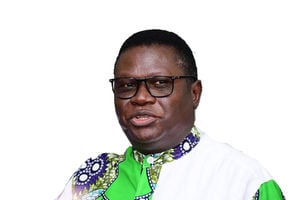Prime
Buganda: a kingdom that can self-govern

Kabaka Muteesa II after he returned from exile in the late 1950s. He would be forced into exile again in 1966 by the Obote I regime. File photo
What you need to know:
Despite infiltration of the kingdom by several ethnic groups, Baganda culture has remained intact, and the most famous Ugandan ethnic group.
An international agency recently revealed that Uganda is one of the countries at a higher risk of falling into the category of failed states by 2030.
The US-based intelligence council project done after every four years also revealed that Uganda and other 14 countries were at risk because they had a higher potential for war, including cyber and biological weapons.
Uganda also has higher potential for environmental ills. Other countries in this category are Afghanistan, Pakistan, Kenya, Burundi, Rwanda, Somalia, DR Congo, Malawi and Yemen, among others.
Prophesy of doom, the report appears to be. But what if, just what if… Uganda failed? Would the centre fail to hold? Would each nation state [ethnic group] in Uganda return to what it was before colonialism? It’s possible but perhaps not likely.
However, in the event that Uganda fails, would Teso, Lango, Ankole, Tooro, Busoga, Acholi or Kigezi, etc be well equipped to manage themselves?
It appears to be a difficult call to make here but Buganda, among all monarchs and cultural groups, is in a fairly better position to forge a nation state.
First, while monarchies elsewhere are facing extinction or stayed ceremonial, Uganda returned active monarchies mainly at the urging of Buganda. Other ethnic groups would later clamour for cultural institutions after seeing Buganda ‘benefiting’ from her organisation.
To date, Buganda is the strongest and most popular monarchy in the Great Lakes region. Not even the more than 70 years of colonial disorientation managed to decimate Buganda nationalism.
This is mainly because it has a well-organised state structure. Of course, this organisation is not a recent matter; the British imperialists managed to subjugate the rest of Uganda using the Kiganda model of administration. The Kabaka remains the rallying point. He is an acceptable leader to all groups in Buganda; political and religious.
The Kabaka has a vibrant Cabinet and legislature. The political infrastructure though latent, exists up to the village level.
Historical facts
Scholars say Baganda had a centralised system of government which by 1750 was the best organised in the inter-lacustrine region.
The head of the State was the king [Kabaka]. Previously the Bataka had a lot of political influence. They enjoyed a position almost similar to that of Kabaka. However, after 175O, the Kabaka assumed a position of political importance far superior to the ranks of the Bataka.
The Kabaka’s position was hereditary but not restricted to any one clan because the king would take the clan of his mother. The Kabaka would marry from as many clans as possible and this encouraged loyalty to the throne in the sense that each of the 52 clans hoped that it would one day produce the king.
The other persons who occupied positions of political and social importance were: the Prime Minister known as the Katikkiro, the Mugema, the royal sister known as Nalinya, the Queen mother known as Namasole and the Naval and Army commanders referred to as Gabunga and Mujasi respectively.
The kingdom was divided into administrative units known as Amasaza (counties) which were further sub-divided into Amagombolola (sub-counties), and these were sub-divided into parishes called Emiruka which were subdivided into sub-parishes.
The smallest unit was Bukungu which was more or less a village unit. All the chiefs at all levels were appointed by the Kabaka and they were directly responsible to him. He could appoint or dismiss any chief at will. After 1750, chieftainship was no longer hereditary. Chieftainship was accorded on clan basis but only to men of merit and distinguished service.
Enduring principles
Despite the interference by the colonialists, Buganda’s system of administration still persists alongside the LC system. The Kabaka still has a full guard both modern and traditional. The authority of the Kabaka is still the rallying point. Defying the Kabaka openly is costly to any modern politician in Buganda.
In fact, the new Katikkiro, Charles Peter Mayiga, has signaled to the fact that the Mengo establishment is ready to confront anyone who does not show respect to the Kabaka, and support anyone, despite their political, tribal or religious affiliations, as long as their pay allegiance to the king.
In other cultural institutions, defying the cultural head could enhance one’s chances of winning an election implying that some cultures had lost the cord that ties them together.
It is not the norm in Buganda. Pro-Kabaka politicians like Betty Nambooze won Mukono North and later Mukono Municipality parliamentary seat on the ‘Buganda ticket’, so is Muwanga Kivumbi in Butambala while Mathias Nsubuga defeated Alintuma Nsambu who was seen as anti-Kabaka.
Anyone who pays allegiance to Mengo easily wins but whoever openly shows hostility against the Kabaka pays a heavy price even if they managed to win an election.
Language
Luganda is easily the most widely spoken language in Uganda while other languages are at the risk of obliteration.
Even in the Diaspora, Luganda is the most spoken Ugandan language among Ugandans. This is a plus for the nation Buganda in terms of international relations. Literature in Luganda is easily available, therefore; unlike others, Buganda’s heritage is the most enduring amidst an onslaught from the global influences.
The influence of the language is seen on social scene with musicians such as Juliana Kanyomozi, a princess in Tooro, who found success in her career using lyrics in the Luganda medium. Jackie Chandiru and Coco Finger are from West Nile but most of their music is in Luganda, Lady Mariam of the Tindatiine fame, started well in her native Runyakore lyrics but to keep her career afloat she turned to Luganda.
At social functions, like weddings, introductions, and other parties, Luganda music is the in-thing from Karamoja in northeastern Uganda to Kanungu in the western part of the country. In public offices, English is the official language but it’s not uncommon to hear Luganda as the main medium of communication. To non-Baganda, it’s even fashionable to speak Luganda.
The media programming in the country also recognises the power of Luganda, hence even national media platforms have some programmes in Luganda.
The highest selling vernacular newspaper is in Luganda.
In commerce, Luganda is the major language. Mengo is also engaged in trade. Mengo receives taxes from mainly those who rent their properties, including the government. They have a fully functional Land Board. Comparatively, Buganda is a rich monarch.
Other aspects
The office of the First Lady is fully functional in Buganda but in the mound of Nnabagereka. She is active in mobilising women. She is in touch with the girl child educating them in culture in her Ekisaakate mentorship programme during holidays.
The youth are taken care of in the Mengo establishment with the most active local sports gala being the Bika bya Baganda. Through this tournament, Buganda has produced more footballers playing with several football teams and the Uganda Cranes. Bika bya Buganda is a football competition among clans, while the Masaza Cup, which is based on counties. It accommodates even the non-Baganda.
This is a plus to Buganda as it’s a significant social avenue to maintain cohesion. Not many cultural institutions have this, thus partly responsible for their lack of cohesion.
And through Nkobazambogo [literally a call to a united action] Buganda has a reservoir of future leaders. In fact most of the current political leaders from Buganda have one way or the other associated with the Nkobazambogo.
Though it is open to non-Baganda members, the ultimate mission is to enable the youth to be creative and preoccupied so as to benefit their king and kingdom.
Other tribes have similar associations, which in themselves are seen as not in tandem with the spirit of nationalism, the Nkozambogo remains the most vibrant. Most armies are built by the youth. Buganda would surely not lack the human resources. Buganda’s recognisation of the need to tap into exuberance of youth in building herself could best be seen in the recent appointment of youthful Mayiga, an accomplished Buganda nationalist, as the Katikkiro.
This shift from old minds to young brains could inadvertently suit Buganda in the event that the nation Uganda fails as projected by the international political watchers. Is it by design? Only the Kabaka knows.
On international front, the Baganda have strong associations and of all Ugandan foods, the Baganda are the most accessible in the diaspora.
In cities like London, Buganda food represent Uganda’s menu. An association like Uganda North American Association [UNAA] is predominantly Baganda partly because they form the majority of Ugandans abroad. Nation Buganda wouldn’t find difficulties managing her foreign relations.
Challenges
Of course like any other cultural institution in Uganda, Buganda has a host of internal challenges.
Pockets of resistance against the Kabaka exist but more like a family feud.
The bigger challenge is the proliferation of small monarchies within Buganda; the Banyala in the Kayunga, the Baruli in Nakasongola and the Sabakoki in Kooki among others. Buganda sees this as an affront from the state. In fact, sources have indicated that before the controversial Land Bill was passed, President Museveni directed the counting of Baganda by ISO and other security organisations to ascertain their exact numbers.
This was reportedly informed by suggestions the Baganda were numerically superior, therefore; passing the Bill against their will would cost him votes. Apparently, the numbers encouraged Museveni and the Bill was passed.
The numbers from clandestine census in Buganda reportedly showed that in districts like Ssembabule, Rakai, Lyantonde, Kayunga, Nakasongola, Kiboga, Mityana and Wakiso, the Baganda could not command the majority.
It could of course turn out to be the jigger in the toe of Buganda but the superior organisation of Mengo compared to other cultural institutions would subdue that challenge.
Ironically, Pan-Africanists or nationalists for that matter saw the restoration of cultural institutions as a drawback.
However, these institutions could turn out to be rallying points if the modern state collapses as predicted.
Most people today have faith in their own cultural groups than the state. This arises partly from the frustrations by the modern state. Salvation remains only in keeping the modern state relevant to the needs of the ordinary people.




